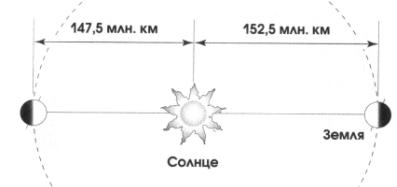|
|
АСТРОНОМИЧЕСКОЕ ОБЩЕСТВО |
|
EURO–ASIAN ASTRONOMICAL SOCIETY |
|
||||||||||||||
|
I I Азиатско-Тихоокеанская I I Asian-Pacific |
||||||||||||||||||
|
|
Россия, Владивосток 4–11. XII. 2006 Vladivostok, Russia |
|||||||||||||||||
Theoretical round
Теоретический тур
|
English
|
Русский
|
|
|
|
|
1. Where is Vladivostok? You see a figure from the book of a Russian popular astronomy writer M.V.Shevchenko, which explains the elliptic character of the Earth’s orbit. Redraw this figure into your answer sheet and point approximately the position of Vladivostok on the image of the Earth, where it is winter midday in Vladivostok. Give the reasons of your answer. 2. Meteor. The meteor is seen from the point A at the altitude 30° over the horizon, the magnitude of the meteor is equal to 0m. The same meteor is seen at a zenith from the point B. What is the magnitude of the meteor at this point? The atmosphere extinction can be neglected. 3. A queer orbit. XXIII century. Midnight. A recently discovered planet in a remote solar type star system (its parallax is equal to 0.003200959") is observed. It is found out, that the circle of the visual motion of the planet in the sky has the radius equal to exactly 0.003200959", however the star is not in the center of this circle but on a half-radius distance from the center. In the first newspaper article devoted to the discovery, the daring assumption has been stated, that high level (in the techniques and law) civilization lives on the planet, which has learned how to break the I Kepler law. Do you have any other assumptions? Find the period of rotation of the planet around the star. Whether the planet (territory outside artificial constructions) is suitable for human’s life if the size and mass of the planet are approximately equal to ones of the Earth? 4. Satellite. It is required to launch an artificial satellite in circular polar orbit around the Earth so that it exactly once (neither more, nor less) a sidereal day would appear at a zenith of the point with geographical coordinates in the latitude of 0° and longitude of 0°. What are the possible periods of revolution of the satellite? Put down the answer as XXHYYM within 1 minute accuracy. 5. 60°. The problem is devoted to the 60-th Moscow astronomical olympiad. The Moscow astronomy amateur observes a star with declination +60° by the telescope with the magnification factor 60 and the field of view 1° (60'). Because of incorrect adjustment the clockwork of the telescope goes in (1/60) faster, than it is required. How long is it possible to observe the star without correction of the telescope? 6. N ´ N ´ N. The problem is devoted to the Moscow astronomical Olympiad. Moscow astronomical olympiad carried out annually, the first Olympiad (I MAO) took place in 1947. Let us assume, that the following problem is given at this Olympiad annually: «Massive spherical cluster has the radius N pc and consists of N millions stars similar to the Sun. One of the stars is moving at the edge of the cluster with the speed N km/s. Whether this star will leave the cluster?». Every year N is equal to the number of the Olympiad. In what years the star could leave the cluster? In what years it can’t leave it?
|
1. Где Владивосток? Перед вами рисунок из книги российского популяризатора астрономической науки М.В.Шевченко, поясняющий эллиптичность земной орбиты. Перерисуйте этот рисунок в тетрадь и укажите примерное положение Владивостока на том из земных шариков, где в Владивостоке – зимний полдень. Ответ аргументируйте. 2. Метеор. В пункте A на высоте 30° над горизонтом наблюдается метеор, имеющий блеск 0m. В пункте B этот же метеор был виден в зените. Какой блеск был у него в этом пункте? Поглощением света в атмосфере пренебречь. 3. Странная орбита. XXIII век. Полночь. При наблюдениях движения недавно открытой планеты у далёкой солнцеподобной звезды (её параллакс равен 0,003200959") выяснилось, что видимое движение планеты по небу происходит по окружности с радиусом также в точности равным 0,003200959", однако звезда находится не в центре этой окружности, а на расстоянии половины радиуса от центра. В первой газетной статье, посвящённой открытию, было высказано смелое предположение, что на планете проживает высокоразвитая (в техническом и юридическом плане) цивилизация, которая научилась обходить (нарушать) I закон Кеплера. А есть ли иные предположения? Найдите период обращения планеты вокруг звезды. Пригодна ли планета (местность вне искусственных сооружений) для жизни землян, если размер и масса планеты примерно равны земным? 4. Спутник. Требуется запустить искусственный спутник Земли на круговую полярную орбиту так, чтобы за одни звёздные сутки он ровно один раз (ни больше, ни меньше) пролетал бы над точкой поверхности Земли с географическими координатами 0° широты и 0° долготы. Каковы могут быть периоды обращения такого спутника? Результаты представьте в виде XXЧYYМ с точностью до 1 минуты. 5. 60°. Посвящается 60-й Московской астрономической олимпиаде. Московский любитель астрономии наблюдает звезду со склонением +60° в телескоп с 60-кратным увеличением и полем зрения 1° (60'). Из-за неверной настройки часовой механизм телескопа идёт на (1/60) быстрее, чем требуется. Сколько времени можно наблюдать данную звезду без коррекции телескопа? 6. N ´ N ´ N. Посвящается Московской астрономической олимпиаде. В Москве ежегодно проводится Московская астрономическая олимпиада, первая такая Олимпиада (I МАО) состоялась в 1947 году. Предположим, что ежегодно на этой олимпиаде даётся такая задача: «Массивное шаровое скопление имеет радиус N пк и состоит из N миллионов звёзд, похожих на Солнце. Одна из звёзд движется на краю скопления со скоростью N км/с. Покинет ли эта звезда скопление?». N каждый год равно номеру Олимпиады. В какие годы звезда может покинуть скопление, а в какие – нет?
|
|
Maximum total time for all jobs is |
Максимальное время
выполнения |
|
|
|
|
|
____________________________________________________________________________________________________________________
Россия, Владивосток 4–11. XII. 2006 Vladivostok, Russia




